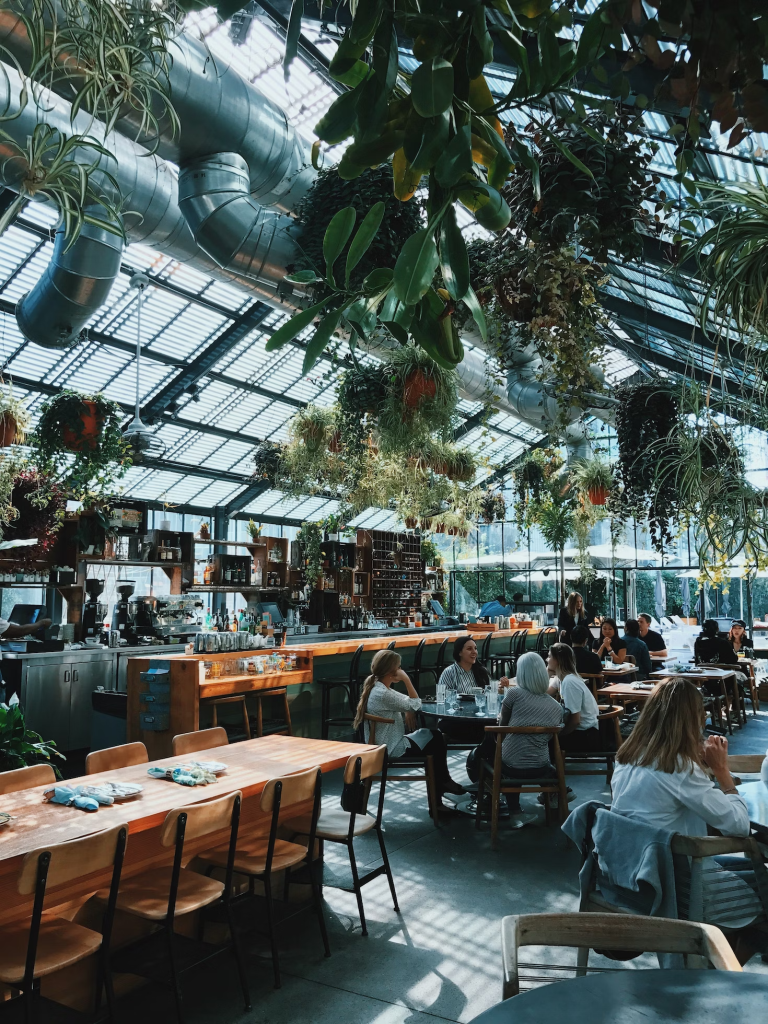A cultural centre that serves more than just coffee and pastries can be found in the middle of every city, town, or neighbourhood. With their aromatic beverages and warm ambience, coffee shops are more than simply places to get a cup of coffee; they are living, breathing parts of society that fill a certain need.
How is a café distinct from any other type of restaurant? Inquiring into the intangibles that make a coffee shop special, rather than just the beans and baristas, this question seeks to understand the essence of these businesses.

Along the way to discovering what makes cafés unique, we will explore the harmony of design, the melody of tastes, the beat of community, and the ever-changing trends that mould these places of solace.
A café can make you feel at ease and connected the second you walk through the door. It’s tempting to stay a bit longer and enjoy more than just the coffee at each café, so let’s explore the many reasons why.
What Makes A Cafe Different?
Amidst the plethora of coffee shops dotting city sidewalks, what distinguishes one cafe from another? Espresso shots and baked goods are the usual fare at most cafes, but what makes a special café special is the totality of its parts, which go beyond just drinking coffee. A cafe is defined by its unique combination of the following, know them by Clicking Here:
- Ambience and Design: The physical space of a cafe plays a crucial role. A well-thought-out interior design, choice of furniture, lighting, and overall ambience contribute to the character of the cafe. Whether it’s a minimalist modern aesthetic or a cozy, vintage charm, the design sets the tone for the entire experience.
- Coffee Craftsmanship: While coffee is a universal language, the way it’s prepared can vary greatly. A cafe that focuses on the craft of coffee, sourcing high-quality beans, and employing skilled baristas who understand the nuances of brewing, can elevate the coffee-drinking experience.
- Distinctive Menu Offerings: Beyond the standard menu, cafes that offer unique and signature drinks or innovative twists on classics can capture the attention of customers. Specialized blends, creative flavour combinations, and a commitment to quality ingredients contribute to a memorable menu.
- Community Connection: Cafes often serve as community hubs, fostering connections among patrons. Whether through hosting events, providing communal spaces, or showcasing local art, cafes that actively engage with their community create a sense of belonging that goes beyond a mere transactional experience.
- Cultural and Social Atmosphere: The atmosphere within a cafe extends beyond physical aesthetics. The vibe, music selection, and overall social environment contribute to the culture of the space. A cafe that embraces diversity and encourages social interaction can become a cultural hub for many individuals.
- Ethical and Sustainable Practices: Increasingly, customers are drawn to cafes that prioritize ethical sourcing of coffee beans, implement sustainable practices, and demonstrate a commitment to environmental responsibility. Such initiatives contribute to the cafe’s identity and resonate with a socially conscious clientele.
- Innovative Technology Integration: Some cafes set themselves apart by incorporating technology into the customer experience. This might include convenient mobile ordering apps, interactive menu displays, or even novel brewing techniques that showcase a commitment to staying on the cutting edge.
What truly sets cafes apart is the way these aspects are carefully blended to form a distinct character, one that speaks to customers on a deeper level than just serving coffee. The goal is to make going to the café more of a special occasion than just another day at the office by providing an unforgettable experience.
What Makes A Cafe Different From A Restaurant?
Though they have the commonality of being places where people can go to eat and drink, cafes and restaurants couldn’t be more different in terms of ambience, menu items, service, and general emphasis. Some things that set cafes apart from restaurants are:
- Casual Atmosphere: Cafes typically have a more relaxed and informal atmosphere compared to restaurants. Customers often visit cafes for a casual and comfortable experience, whether it’s for a quick coffee, a leisurely chat, or a light meal. The emphasis is on creating a welcoming environment for socialising and relaxation.
- Service Style: The service style in cafes is generally more laid-back and counter-service-oriented. Customers often place their orders at the counter and may be responsible for picking up their food and beverages. In contrast, restaurants typically offer table service, with waitstaff taking orders and delivering food to the table.
- Menu Focus: Cafe menus typically emphasize beverages, such as coffee, tea, and specialty drinks, as well as light meals, pastries, and snacks. While some cafes do offer a broader menu, the primary focus is on providing a variety of beverages. Restaurants, on the other hand, have more extensive menus that often include appetizers, entrees, desserts, and a wider range of culinary options.
- Timing and Hours: Cafes are often open for extended hours, catering to customers looking for a morning coffee, a midday snack, or a place to work in the afternoon. They may also serve breakfast and lunch items throughout the day. Restaurants typically have more defined meal times, with specific hours for breakfast, lunch, and dinner, and may close during non-meal hours.
- Social Space vs. Formal Dining: Cafes are often designed as social spaces where people can meet, work, or relax in a more informal setting. The seating arrangements in cafes are usually more varied, including communal tables, cozy nooks, and outdoor seating. Restaurants, on the other hand, are designed for formal dining, with a focus on creating an intimate setting for a meal.
- Alcohol Service: While some cafes may serve alcoholic beverages, the primary focus is usually on non-alcoholic drinks. Restaurants, in contrast, commonly offer a selection of wines, beers, and cocktails to complement their meals.
- Culinary Complexity: Restaurants often emphasize culinary artistry, with chefs creating complex and refined dishes. Cafes, while still valuing quality, tend to have more straightforward food offerings, with an emphasis on freshness and quick preparation.
Keep in mind that these are only broad strokes and that there is often overlap between cafés and restaurants—particularly with the rise of hybrid businesses that offer a combination of the two. The aforementioned aspects, however, do serve to emphasise the common distinctions between restaurants and cafés in terms of ambience, service, and emphasis.
Conclusion
The difference between cafes and restaurants extends beyond just serving food; it’s in the varied ambiences, service methods, and culinary emphasis that each place offers.
Cafes provide a place for people to meet for casual conversations, relax, and enjoy some light food and drinks. People looking for a casual place to relax or meet up with friends will like the longer hours, counter service, and relaxed atmosphere.
Restaurants, on the other hand, are living embodiments of the fine dining tradition, with their formal service, set meal hours, and extensive menus that highlight the artistry of the cooks. The focus is on designing cosy spaces where customers may savour expertly prepared meals and have a memorable dining experience.
Hybrid concepts that muddy the waters between cafés and restaurants have emerged in response to the ever-changing terrain of culinary trends, while these distinctions do offer a general framework.
It is now commonplace to discover restaurants that offer both a laid-back atmosphere and varied and sophisticated food, blending the two concepts in perfect harmony.
Each type of establishment serves a distinct purpose in meeting varied tastes and making experiences unique, whether one is looking for the cosy atmosphere of a cafe or the exciting gastronomic adventure of a restaurant.
While these places continue to reshape how we socialise, enjoy food and drink, and choose between cafes and restaurants, the decision usually comes down to the event, individual tastes, and the ambience we’re going for.
https://www.youtube.com/watch?v=re3JZ989l94&pp=ygUcV2hhdCBNYWtlcyBBIENhZmUgRGlmZmVyZW50Pw%3D%3D



Leave a Reply